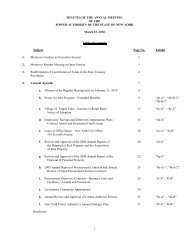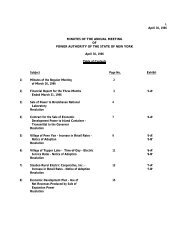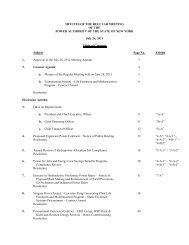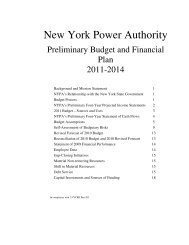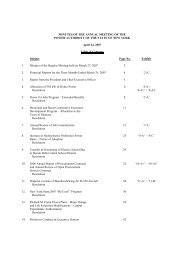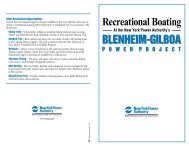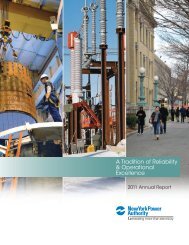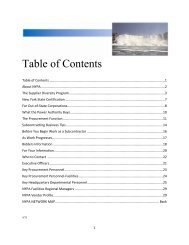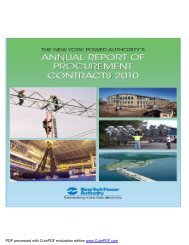Minutes of the Annual Meeting of the Power - New York Power ...
Minutes of the Annual Meeting of the Power - New York Power ...
Minutes of the Annual Meeting of the Power - New York Power ...
You also want an ePaper? Increase the reach of your titles
YUMPU automatically turns print PDFs into web optimized ePapers that Google loves.
April 24, 2007<br />
representatives from MEUA, NYAPP and NS Customers. In addition to oral or written comments delivered at <strong>the</strong><br />
public forum, written comments were accepted if received before <strong>the</strong> close <strong>of</strong> <strong>the</strong> public comment period. The<br />
public comment period was extended for one week, from April 2, 2007 to April 9, 2007, based on customers’<br />
feedback. By April 9, <strong>the</strong> Authority received written comments from MEUA, NYAPP and NS Customers. The<br />
transcript <strong>of</strong> <strong>the</strong> public forum and all written comments are attached as Appendix ‘8-C.’<br />
“All <strong>of</strong> <strong>the</strong> public comments were evaluated by Authority staff. The Staff Analysis, a detailed description<br />
<strong>of</strong> <strong>the</strong> issues raised and staff’s recommendations, is contained in Appendix ‘8-A.’ The following is a summary <strong>of</strong><br />
staff’s disposition <strong>of</strong> <strong>the</strong> issues.<br />
Staff Analysis <strong>of</strong> Public Comments<br />
Prudency <strong>of</strong> Niagara Project Upgrade: NYAPP claims that <strong>the</strong> Authority’s proposed rate increase cannot be<br />
sustained because <strong>the</strong> $298 million <strong>of</strong> <strong>the</strong> Niagara Project Upgrade costs included in <strong>the</strong> CoS were imprudently<br />
incurred. This is premised on <strong>the</strong> mistaken notion that <strong>the</strong> Upgrade produced insufficient additional benefits to <strong>the</strong><br />
preference customers to warrant charging <strong>the</strong>se customers for <strong>the</strong> proposed amount <strong>of</strong> such costs. The Authority, <strong>of</strong><br />
course, did allocate to preference customers (consistent with <strong>the</strong> Niagara Redevelopment Act) <strong>the</strong> increased firm<br />
capacity that arose from increased efficiency <strong>of</strong> <strong>the</strong> upgraded turbines, as required under its contractual and license<br />
commitments. As <strong>the</strong> Staff Analysis shows, NYAPP misunderstands <strong>the</strong> purposes <strong>of</strong> <strong>the</strong> Upgrade and ignores <strong>the</strong><br />
extensive nature <strong>of</strong> <strong>the</strong> work conducted to extend <strong>the</strong> life <strong>of</strong> <strong>the</strong> Project so that it could continue its generating<br />
capabilities for decades into <strong>the</strong> future. The Authority recommends no adjustment to <strong>the</strong> CoS based on this<br />
argument.<br />
Increased Credit for Ancillary Services Production: NYAPP claims that <strong>the</strong> Authority’s continuation in <strong>the</strong> Rate<br />
Modification Plan <strong>of</strong> <strong>the</strong> method introduced in 2003 to credit <strong>the</strong> CoS with <strong>the</strong> value <strong>of</strong> <strong>the</strong> ancillary services<br />
production costs results in an inappropriately low credit, and that it should be dramatically increased. However, <strong>the</strong><br />
current method for providing an ancillary services production credit was previously agreed to in <strong>the</strong> customers’<br />
settlements with NYPA, and <strong>the</strong>re is no basis to revisit it here. NYAPP’s claim is also inappropriate because it is<br />
based on <strong>the</strong> mistaken premise that <strong>the</strong>re is now more firm capacity available from <strong>the</strong> Niagara Project than is <strong>the</strong><br />
case. While NYAPP is careful to point out that it is not seeking a share <strong>of</strong> <strong>the</strong> Authority’s gross ancillary services<br />
revenues from sales into <strong>the</strong> <strong>New</strong> <strong>York</strong> Independent System Operator (‘NYISO’) (such a claim would be disallowed<br />
under <strong>the</strong> terms <strong>of</strong> <strong>the</strong> Auer settlement) its proposal would none<strong>the</strong>less undo <strong>the</strong> existing crediting methodology to<br />
which NYAPP’s members and <strong>the</strong> all <strong>the</strong> o<strong>the</strong>r municipal customers have agreed. 1 As Staff’s Analysis shows, <strong>the</strong>re<br />
is no additional Hydro Project firm capacity being diverted from <strong>the</strong> preference customers when NYPA makes<br />
ancillary services sales to <strong>the</strong> NYISO, and <strong>the</strong> current quantity <strong>of</strong> MW upon which <strong>the</strong> cost-based credit is based is<br />
appropriate. NYAPP does not dispute that <strong>the</strong> Authority provides <strong>the</strong> appropriate cost-based credit based on <strong>the</strong><br />
total amount <strong>of</strong> sales from <strong>the</strong> Hydro Projects (including sales <strong>of</strong> ancillary services) when it does its annual<br />
reconciliation to <strong>the</strong> Rate Stabilization Reserve (‘RSR’). NYAPP has provided no basis to change <strong>the</strong> way <strong>the</strong><br />
Authority has treated <strong>the</strong> revenues from such sales, a practice followed in <strong>the</strong> 2003 rate proceeding and continued in<br />
<strong>the</strong> Rate Modification Plan.<br />
Inflation Compensation Adjustment: MEUA argues that <strong>the</strong> Authority has used <strong>the</strong> incorrect Handy-Whitman Index<br />
(‘HWI’) numbers in calculating <strong>the</strong> annual inflation compensation adjustment used in <strong>the</strong> CoS. MEUA proposed<br />
that <strong>the</strong> initial HWI number used should be that for July 1, 1981 and not <strong>the</strong> July 1, 1980 number that has been used<br />
in all <strong>of</strong> <strong>the</strong> Authority’s CoS analyses. The change in <strong>the</strong> HWI for <strong>the</strong> 12 months ended July 1, 1981 was 7.5%,<br />
while that for <strong>the</strong> 12 months ended July 1, 1982 was 4.5%. MEUA proposes that <strong>the</strong> Authority restate more than 20<br />
years <strong>of</strong> cost studies and make a $11.5 million positive adjustment in <strong>the</strong> RSR. NYAPP and NS Customers concur<br />
in this proposal. Staff does not recommend changing <strong>the</strong> base period HWI to July 1, 1981 from July 1, 1980. The<br />
choice <strong>of</strong> <strong>the</strong> July 1, 1980 starting date was appropriate and necessitated by <strong>the</strong> availability <strong>of</strong> data at <strong>the</strong> time <strong>of</strong> <strong>the</strong><br />
initial studies. To change <strong>the</strong> base year now would amount to rolling back <strong>the</strong> clock on more than 20 years <strong>of</strong> cost<br />
1<br />
Though it is not entirely clear, it appears that <strong>the</strong> NS Customers adopt a similar argument to claim a larger cost-based credit for producing<br />
ancillary services at <strong>the</strong> Hydro Projects. To <strong>the</strong> extent <strong>the</strong> NS Customers are requesting such inflated credit, <strong>the</strong>ir claim is disposed with in <strong>the</strong><br />
same manner as NYAPP’s. To <strong>the</strong> extent <strong>the</strong>y are claiming a direct share <strong>of</strong> NYPA’s ancillary services sales revenue, that is a violation <strong>of</strong> <strong>the</strong><br />
Auer Settlement principles to which <strong>the</strong>y have agreed. See section entitled ‘Request for Credits for Energy Sales into NYISO.’<br />
24



